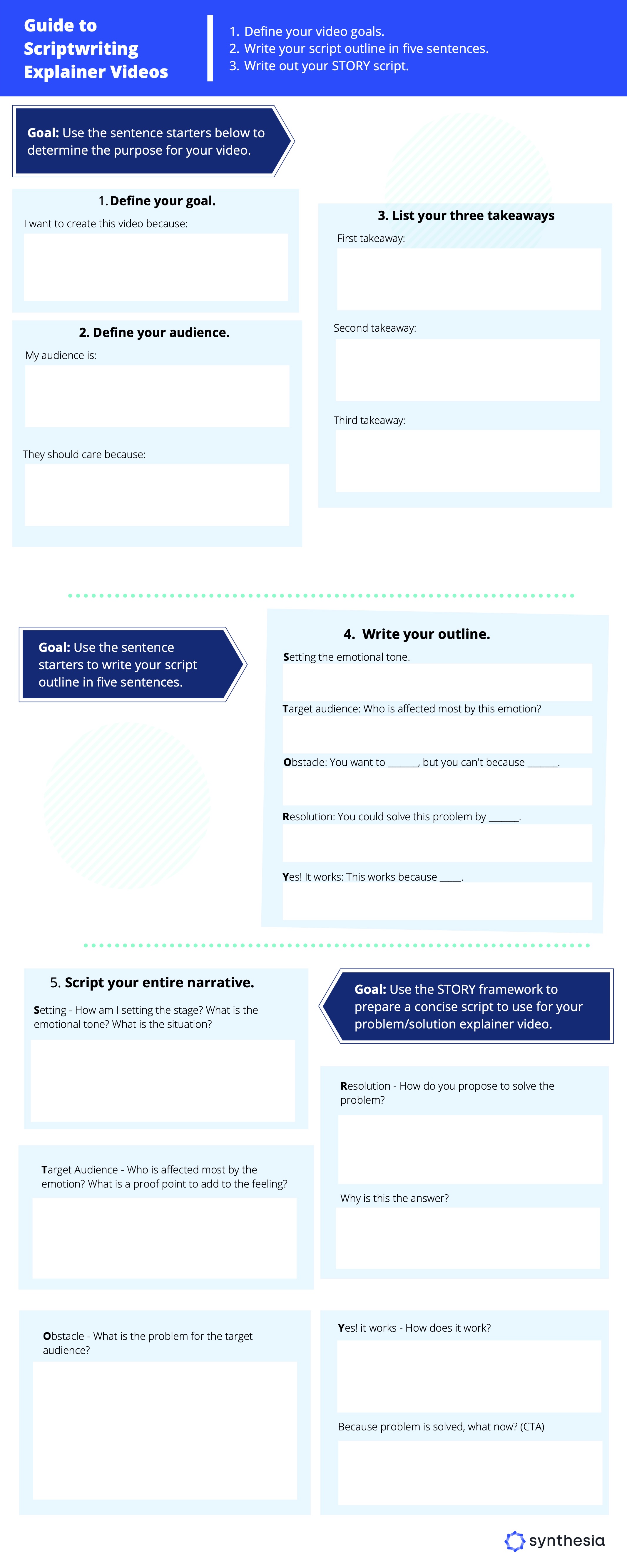
Create AI videos with 230+ avatars in 140+ languages.
Convert your scripts into AI videos with 230+ avatars in 140+ languages
There's nothing worse than staring at a blank page while anxiously trying to develop a successful video script.
There are SO many things you could write…. So how do you prioritize?
This post will provide you with eight free video script templates, one for each of the main types of training, instructional, or marketing videos you might need, backed by:
✔️ An example video
✔️ Specific best uses
✔️ The downloadable version of the video script template
You can decide which video best suits your content, snatch the template, and run your script through a free AI text to video tool like Synthesia. You can also try our script to AI video generator or check out our guide to converting a script into an engaging AI video.
1. Training video script template
Training videos teach someone — an employee or a customer — how to do a task, use a product, or follow a process.
See a training video example in action:
When to use training videos:
✔️ To teach employees how to use new software or technology updates.
✔️ To train new employees on company procedures and policies.
✔️ To educate customers on how to use your products or services.

2. Explainer video script template
Explainer videos clarify what a product, service, or company is and how it can benefit the viewer.
See an explainer video example in action:
When to use explainer videos:
✔️ To showcase the benefits of a product or service to potential customers.
✔️ To explain a complex app or technology so your employees will understand it.
✔️ To introduce a new concept or idea to potential investors or stakeholders.

3. Onboarding/orientation video script template
Onboarding or orientation videos introduce your new hire to your company's culture, policies, and procedures and provide an overview of their roles and responsibilities.
See an onboarding/orientation video example in action:
When to use onboarding/orientation videos:
✔️ To help new hires familiarize themselves with the company culture and DE&I policies.
✔️ To set expectations for the first days with a clear timeline and an action checklist.
✔️ To create video marketing campaigns, present company benefits, office setup, or even emergency procedures.

4. Product demo video script template
Product demo videos demonstrate how your product or service works, showing its main features and benefits. They can have an informational role or be a powerful marketing tool.
See a product demo video example in action:
When to use product demo videos:
✔️ To train employees on how to use and sell a product.
✔️ To showcase products to potential customers with video testimonials and other compelling visuals.
✔️ To demonstrate the use and benefits of a product to a sales team or distribution network.

5. Listicle video script template
Listicle videos present a topic in a list format, and they can educate, train, or entertain the audience, depending on the chosen topic.
See a listicle video example in action:
When to use listicle videos:
✔️ To highlight the top features or benefits of a product or service.
✔️ To showcase a series of related tips or tricks on a particular topic.
✔️ To provide a roundup of industry trends or best practices.

6. How-to video script template
How-to videos, also known as instructional videos or tutorial videos, teach your audience a concept, an action, or a skill, in a sequence of logical steps they can easily replicate.
See a how-to video example in action:
When to use how-to videos:
✔️ To demonstrate how one of your products or services can be used.
✔️ To teach your audience how to complete a specific task or process.
✔️ To educate the viewers on troubleshooting a common issue or problem.

7. Educational video script template
Educational videos combine clear explanations with engaging visual and audio elements to teach an audience about a specific subject or skill, typically in a classroom or online learning environment.
See an educational video example in action:
When to use educational videos:
✔️ To provide ongoing education to employees or customers.
✔️ To facilitate a more comprehensive overview of a topic.
✔️ To facilitate the understanding of more complex processes or systems.

8. Product tour video script template
Product tour videos present a product or service and demonstrate its value proposition in a marketing or sales context.
See a product tour video example in action:
When to use product tour videos:
✔️ To showcase your latest product and highlight its benefits to potential customers.
✔️ To provide minimal information to an audience who can't attend an in-person presentation.
✔️ To create a knowledge base for your sales or customer support team.

7 mistakes to avoid when filling in your video script template
Not starting your videos from scratch is a big advantage. Still, watch out for the following mistakes you could make when filling in the script template for your video.
1. Not customizing the template
It's tempting to think that using a template requires minimum work. But templates are fillable for you to put in the right words. Not customizing it will get you a generic script that most viewers won't find engaging enough.
💎 Try to make it serve your needs and speak your audience's language.
2. Focusing too much on the template
While a video script template is a useful starting point, don't feel you can't make changes.
💎 Make your script your own, adapt it to your specific goals and audience, remove some slides, or add new ones if you feel it'll better convey your message.
3. Being too wordy
Using too many words, overly complex language, or unnecessary humor makes it harder for the audience to follow along and grasp the message in your video. An interview script, for instance, is something to approach with caution.
💎 Your script should be concise. Don't be afraid to cut out words if you can say the same thing in a more condensed version. While you eliminate words, you add value to your video.
4. Approaching visuals the wrong way
Sometimes, you stuff the video script template with visuals that catch your eye and you think will wow your audience. But the purpose of visuals is to support the narration.
💎 Consider what visuals will accompany the script and how the two will work together to communicate your message effectively.
5. Not considering the pacing
The pacing of your video clips is more difficult to outline in a script. It is partially guided by how many sentences you put on each slide and how you display your visuals. But…
As you start combining narration with visuals in the video creation process, you risk making too abrupt transitions or tone changes.
💎 Read the script aloud many times. Try to assess the rhythm and flow as you write your script and during the production.
6. Forgetting to recap before the call to action
A call to action not preceded by a video recap is incomplete and not strong enough.
Most viewers aren't motivated to take action by videos that end without reminding them what they learned and the utility of it.
💎 There's one specific slide in your video script template to which you should pay great attention. It's where you summarize the key points before launching into the call to action.
7. Failing to revise and edit
When you don't revise and edit the video content several times, you're not making it as effective or engaging as possible. And if you do the whole editing in one day, you risk missing important details.
💎 Best to do several revisions and edit the video content on different days. That way, you'll get to detach and gain some clarity before you return to the drawing board.
8 tips on making a successful video script
Here's what a video script must include to capture the mind and attention of your audience:
- A clear message.
- A solid, logical content structure.
- A deliberate audience engagement strategy from the beginning until the end.
Good video scripts help you effortlessly hit those three points on the head and save time.
But, like most good things in life, crafting the script for your video is not as simple as filling in the blanks. Nor is it about writing paragraphs and paragraphs of detail. You need to think deeply about your audience to write a script that gives them just the right amount of information. The following video scriptwriting tips show you how to do just that!
Tip #1: Get precise on who's your audience
Everything in your video script template should speak to your ideal talking avatar.
💎 Before writing any word, make sure you know the following:
- Who's the person watching your video?
- What's their motivation? What do they hope to get from your video?
- What do they already know about the information you'll provide in the video?
- What can you say that's new to them and will boost their motivation?
Tip #2: Clarify your desired outcome
The outcome of your video is a distillation of purpose. With outcome clarity, you'll know how to adjust the video template so every element you add serves your goal.
💎 Ask yourself before you start writing:
- What action do you want your audience to take when they finish watching?
- Within what timeframe should your audience respond to your call to action?
- What specific action taken by them will confirm that you've reached your video outcome?
Tip #3: Aim for a conversational tone
Videos with fancy vocabulary or industry jargon are a turn-off. By contrast, a tone that makes the information more accessible will help establish a connection with your viewers.
💎 Regardless of your audience profile and video goal, use simple, conversational language anyone can understand.
Tip #4: Avoid information overload
Saying less in each slide of the video script template helps you leverage your audience's attention span. You'll use more slides and transitions, thus keeping your viewers watching.
💎 Stick to a maximum of 3-4 narration sentences per video scene.
Tip #5: Use the most supporting visuals for your narration
💎 Consider using one or more of the following techniques and visuals to improve and personalize your video script template:
- A talking head can heighten the emotional impact if used right. Film the same person from different angles, highlighting the key messages with a medium close-up frame.
- B-rolls are excellent for adding context without using too many words. To make an impact, have them fill the entire slide.
- Screen recordings are best for clear, step-by-step demonstrations.
- The text-on-screen with different transitions and sound effects can help make specific messages stick. Just be sure to write only the essentials, not the entire narration.
- Charts or graphs are great for helping an audience make sense of lots of data. Bonus points if you can squeeze in an infographic too.
Tip #6: Alternate visuals for increased engagement
Back your video scripts with relevant and diverse visual cues. This will help you keep your viewers engaged with the content for longer.
💎 Write down what visuals you'll use for each section of your video and see if any particular visual is overused. If so, use tip #5 to come up with alternatives.
Tip #7: Read your script aloud more than once
Quiet reading processes information internally within the mind. Aloud reading involves more complex information processing through hearing and speaking.
💎 Read your video script template aloud as you customize it. You'll identify errors and awkward phrasings, replace the difficult words, and adjust your sentence flow easier.
Tip #8: Ask for feedback from a colleague
Two pairs of eyes pick up more details. And when adjusting your video script templates, the details can make a difference.
💎 Share your Google Docs script with someone you trust for a second opinion. You'll get a different, more detached perspective.
Use a free video script template & customize it for making a professional video
Each free video script template you saw in this guide is a perfect starting point for its intended use cases. Whatever your next video project, you won't have to go from zero.
To make creating your video clips truly easy, pair your effective script template with the principles that help refine your message for your audience and intended outcome. Browse through the entire collection of Synthesia's video templates and start writing.
About the author
Learning Strategist & Speaker
Elly Henriksen
Elly Henriksen is a accomplished instructional designer exploring the impact of AI-generated content on learning design. With eight years of experience across both professional and higher education institutions, notably The University of Washington, Elly provides an insightful perspective on the transformative power of synthetic media for learners and instructional designer. Her versatile roles, from course facilitator to eLearning author and LMS administrator, give her a unique vantage point on the evolving trends in instructional design and how AI impacts the learning landscape. Explore Elly's insights and her pursuit of leveraging AI to redefine the future of the learning world.

Frequently asked questions
What is a video script template?
A video script template is a written document that outlines the dialogue, visual and audio elements, scene setups, characters, and other pieces you'll include in the video.
The script makes it easy to see how you'll achieve your video outcome through all the narration and visuals combined. It's your video creation roadmap.
A straightforward video script will save time and provide everyone involved in the project with the necessary information to do their job at their best. And it will help ensure that your videos effectively communicate the desired message to the audience.
What should be included in a video script?
The video script template should outline each scene comprising the video in a logical sequence, and you can lay it out even in Google Docs.
With every scene, you should include a name (show what's it about), narration details (show what words will be spoken while that scene is displayed), and visuals (show what images and data will be visible on the screen while that scene is displayed).
For the narration column, think about your audience. What kind of language will best speak to their pains? Based on their prior knowledge, what can you tell them that will keep them hooked? And how can you motivate them to follow your key messages and call to action?
Consider what video content would best demonstrate the narration in the visuals column. Select the visuals that help you show the most while using fewer words. And alternate different visual elements to make it relevant and engaging to most viewers.
How do you start a good script?
A good script makes your audience pay attention using one of the following elements: familiarity, directness, curiosity, or surprise. An effective video script template will suggest you open the video in one of the following ways:
- Make it clear what's this video about and why they should watch it.
- Show them the result and promise to give them a path to it.
- Introduce the main character.
- Tell them what they're missing out on.
- Ask them a thought-provoking question.
- Share a surprising fact or a stat that makes them curious.
How do you end a good script?
The end of the video is where you drive action. That's why the best videos end with a bang. The whole point of the video content is to make the audience take a specific action. And what you're saying in your last slides is crucial to reaching your outcome.
End your video with content that heightens your audience's emotions. Remind them what they learned and how all that will help them solve a pain. Then, building on this peak of enthusiasm, use strong and definitive language and ask them to take action.
With a winning closing, you'll increase your chances of driving action, leaving them wanting to watch more of your videos.
What software can help you create and use a video script template?
You can use several software programs to create a good script, most requiring a fee: Adobe Story, Celtx, or Final Draft.
Alternatively, you can write your video script template in a Microsoft Word document or Google Docs and use it to create a video piece by piece in an AI video maker like Synthesia.
Synthesia offers various tools and resources to help you create effective video scripts, including our AI script generator tool and many video templates for training, explainer, onboarding/orientation, product demo, listicle, how-to, educational, and product tour videos.
How should I format my script for the best results?
Use a storyboard approach with separate columns for each element: the section name, on-screen recordings, on-screen text, visual assets, and what your narrator will say. This format helps you plan how all the pieces work together and ensures proper synchronization between narration and visual elements.
What writing style works best for video scripts?
Keep your language simple and conversational, like you're talking to a friend rather than writing a formal report. Use natural speech patterns instead of stiff, written language. If you're using AI avatars in your video, they sound more realistic when you write scripts that match how people actually speak in everyday conversations.











